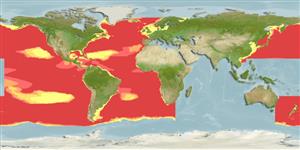>
Aulopiformes (Grinners) >
Paralepididae (Barracudinas)
Etymology: Magnisudis: Latin, magnus = large + Latin, sudis = esox, fish of the Rhine, cited by Plinius 9.15; it also means "stake" (Ref. 45335).
Environment: milieu / climate zone / depth range / distribution range
Écologie
marin; océanodrome (Ref. 51243); profondeur 0 - 4750 m (Ref. 58018). Deep-water; 69°N - 61°S, 180°W - 180°E
Circumglobal: From Arctic to Antarctic. Northwest Pacific: Bering Sea, Kamchatka and Kuril Islands (Ref. 41668). Eastern Pacific: southeast Alaska (59°N) to Chile (Ref. 35950). Western Atlantic: 38°N to the Gulf of Mexico, Bermuda, and the Caribbean Sea (Ref. 37039).
Taille / Poids / Âge
Maturity: Lm ? range ? - ? cm
Max length : 56.0 cm SL mâle / non sexé; (Ref. 557); common length : 43.0 cm SL mâle / non sexé; (Ref. 4473)
Épines dorsales (Total): 0; Rayons mous dorsaux (Total): 9-12; Épines anales 0; Rayons mous anaux: 20 - 24; Vertèbres: 60 - 69. Branchiostegal rays: 8.
Oceanic species of medium depth range. Large adults approach the coasts in temperate and polar zones (Ref. 35950). Meso- and bathypelagic (Ref. 58302). Spawns throughout the year in tropical and subtropical seas (Ref. 35388). Seems to spawn in the Sargasso Sea. Feed on small fishes and shrimps. Preyed upon by sharks, tuna, and whales.
Life cycle and mating behavior
Maturité | Reproduction | Frai | Œufs | Fécondité | Larves
Post, A., 1990. Paralepididae. p. 373-384. In J.C. Quero, J.C. Hureau, C. Karrer, A. Post and L. Saldanha (eds.) Check-list of the fishes of the eastern tropical Atlantic (CLOFETA). JNICT, Lisbon; SEI, Paris; and UNESCO, Paris. Vol. 1. (Ref. 4473)
Statut dans la liste rouge de l'IUCN (Ref. 130435)
Menace pour l'homme
Harmless
Utilisations par l'homme
Plus d'informations
RéférencesAquacultureProfil d'aquacultureSouchesGénétiqueElectrophoresesHéritabilitéPathologiesTraitementNutrientsMass conversion
Outils
Articles particuliers
Télécharger en XML
Sources Internet
Estimates based on models
Preferred temperature (Ref.
123201): 2 - 7.2, mean 3.8 °C (based on 2973 cells).
Phylogenetic diversity index (Ref.
82804): PD
50 = 0.6250 [Uniqueness, from 0.5 = low to 2.0 = high].
Bayesian length-weight: a=0.00224 (0.00090 - 0.00555), b=3.14 (2.92 - 3.36), in cm total length, based on LWR estimates for this (Sub)family-body shape (Ref.
93245).
Niveau trophique (Ref.
69278): 3.7 ±0.0 se; based on diet studies.
Fishing Vulnerability (Ref.
59153): Moderate to high vulnerability (47 of 100).
Nutrients (Ref.
124155): Calcium = 23.2 [10.6, 67.7] mg/100g; Iron = 0.58 [0.21, 1.36] mg/100g; Protein = 15.3 [12.3, 17.7] %; Omega3 = 0.243 [0.077, 0.655] g/100g; Selenium = 28.7 [8.4, 79.2] μg/100g; VitaminA = 7.9 [1.4, 44.7] μg/100g; Zinc = 0.347 [0.208, 0.564] mg/100g (wet weight);
